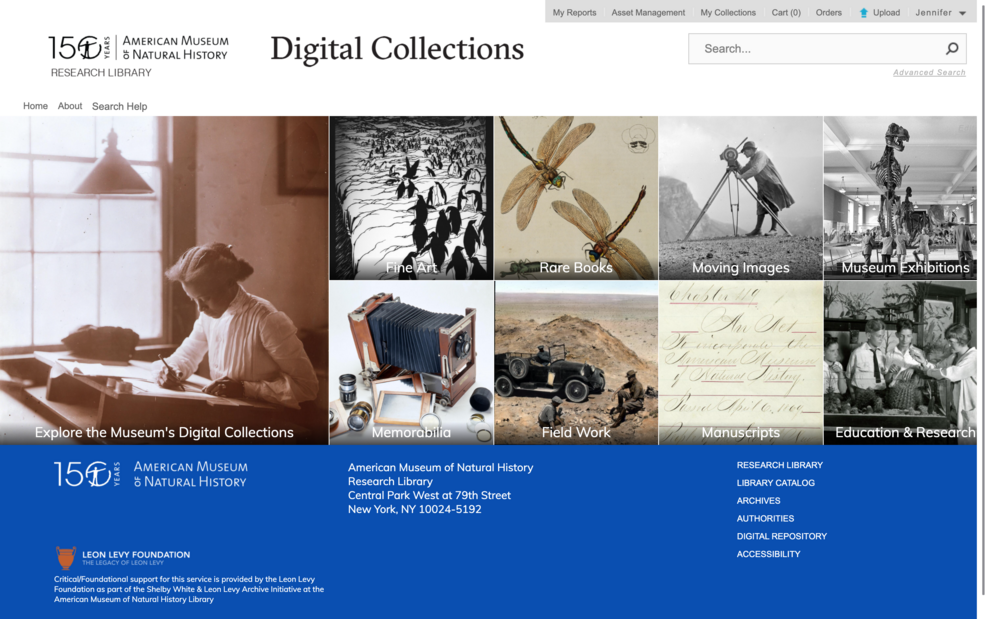Shelby White & Leon Levy Archives Initiative—Digital Assets Initiative Year One Update
by Kendra Meyer on
© AMNH/R.E. Logan
We were able to get off to a seamless start and have made considerable progress in the first year of our project, including developing a functional prototype of the Digital Asset Management System database. Early in 2020, the Library started discussions with Orange Logic as the DAM software vendor for use of their Cortex software. The Levy Digital Archivist and Digital Systems Librarian collaborated closely in order to complete preparatory work for the data migration to Cortex, including identification of project scope, goals and benchmarks, and an export of digital image asset metadata from the existing platform Omeka. This metadata was then edited, normalized, and enhanced. The digital assets themselves were reviewed and arranged into a useful organizational structure. There was no existing repository for film and audio assets, so metadata was collected and normalized. The Digital Archivist also drafted workflows and policies for digital preservation, accession, and ingest to support later stages of the project.
© AMNH/J. Kirschner
Because the nature of this early project stage was exclusively digital, the project team was well positioned to transition to fully remote work when the Museum closed its facilities due to the COVID-19 pandemic in early March. Although we had expected to initiate the contract with Orange Logic in January or February of 2020, the process was delayed. As soon as the contract was finalized in May, we began working with the Orange Logic implementation team to design and customize our instance of the DAM over an intense work period of several months. In order to meet the Library’s unique needs, the Digital Systems Librarian and Levy Digital Archivist provided the implementation team with guidance and compiled data sets for permissions, security, metadata field requirements, the keyword library, the design and appearance of the site, and the functional requirements. Once a beta site was in place, the Systems Librarian and Levy Digital Archivist began training with Orange Logic while identifying and troubleshooting functionality issues. In the late summer and fall, we practiced uploading assets into the system, tested workflows, and created cataloging guidelines and a style guide for metadata best practices. We then began rolling out training to Library staff. Additional communication with Orange Logic on outstanding or new issues continues and is ongoing.
To date there are nearly 40,000 total Library Assets uploaded to our site, a number which continues to grow as additional assets are incorporated. Although the official site launch is in the fall, please check out our progress until then. We are accessioning some compelling new digital archival material into our Collection including archived film project material from the Editorial Department and several interesting new image collections. This gives us a timely opportunity to put into practice the digital archiving workflows we have developed earlier in the project. We have also initiated exciting collaborations with other Museum departments such as the Global Business Development office and the Center for Biodiversity and Conservation to potentially integrate the DAM into their workflows. These internal partnerships have begun earlier than our anticipated timeline, but the timing is nevertheless proving to be ideal. We are now–sooner rather than later—identifying and solving challenges inherent in these partnerships, from asset ingest (such as duplicate material), description (conflicting metadata schema), and coordination of different asset workflows and delivery systems. Although the project is challenging, it is equally satisfying, and we are thrilled to continue on this journey towards creating a Digital Asset Management system that will allow the Library to make all its assets in all formats accessible and meet our ultimate goal to provide an infrastructure for digital assets from across the Museum.
This is the twenty-first post in a series about how the Library's staff is working remotely and enriching its digital collections to enhance access to researchers and the public during the COVID-19 pandemic. This entry was written by Kendra Meyer, Shelby White & Leon Levy Digital Archivist.
